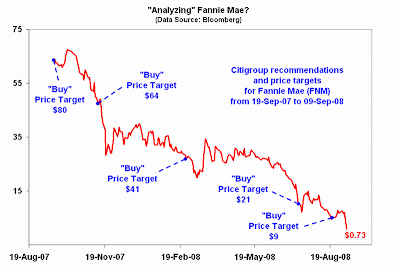Nothing to see here, move on.
We can certainly let a doubling of the publicly traded debt go unnoticed as long as our cyber colonies keep sending us their people's life savings.
Cost of US loans bail-out emerging
By Krishna Guha, Michael Mackenzie,and Nicole Bullock
September 10 2008 00:34
Financial Times
The US on Tuesday began to face the financial consequences of the bail-out of Fannie Mae and Freddie Mac after Congress’s budget watchdog said the housing giants’ operations should sit on the government’s books and the cost of insuring against a US default crept higher.
With the stock market tumbling, the non-partisan Congressional Budget Office said the government takeover of Fannie and Freddie meant the companies should no longer be regarded as outside the public sector.
Peter Orszag, CBO director, said: “It is the CBO view that Fannie Mae and Freddie Mac should be directly incorporated into the federal budget.” (They are right, but keep in mind they could not get the Iraq war on the books - Jesse)
The Bush administration appeared to be caught by surprise. A spokeswoman for the Office of Management and Budget told the Financial Times: “We are working through this issue with Treasury and other stakeholders.” (Watchdogs? We don't need to listen to no stinking Watchdogs! - Jesse)
The White House could take a different view on Fannie and Freddie and exclude them from its budgets. But this would be difficult because the CBO is regarded as the leading independent authority on US finances and its assessments guide spending decisions by Congress. (Yeah the Bush White House is so concerned with peer pressure - Jesse)
The two mortgage companies have between them $5,400bn in liabilities, equal to the entire publicly traded debt of the US, alongside mortgage-related assets of about equal value. These will now all be accounted for by the CBO, although public accounting rules mean that its tally of US government debt may not necessarily increase by $5,400bn.
The CBO bombshell came as it raised its baseline estimate for the US budget deficit to $407bn this year and a record $438bn next year owing to falling revenues and higher spending, some of it related to the fiscal stimulus.
The price of credit default swaps on five-year US government debt hit a record 18 basis points in early trading, according to CMA Datavision. This means that it costs $18,000 a year to buy insurance on $10m of US government debt.
Tim Backshall, chief strategist at Credit Derivatives Research, said the price implied that the US was more likely to default on its obligations than Japan, Germany, France, Quebec, the Netherlands and several Scandinavian countries. Traders said the CDS market for US debt was illiquid and it was hard to see evidence of increased concern over US creditworthiness in broader market prices. (Give it some time and we might be able to add Venezuela, Argentine, Trinidad and Tabago to that list - Jesse)
The price of US government bonds rose and yields fell across the board, as concern over the economic outlook overwhelmed any rise in perceived credit risk. Jay Mueller, senior portfolio manager at Wells Capital Management, said: “We are seeing flight-to-quality buying of Treasuries.”
Both Standard & Poor’s and Moody’s Investors Service said the government takeover of Fannie Mae and Freddie Mac did not affect the US’s triple-A sovereign credit ratings. “It does represent some deterioration in the US balance sheet, but it’s well within what we would call the triple-A space,” said Steven Hess, senior credit officer at Moody’s. (These jokers didn't problems at the monolines as they were going bankrupt. They must be wearing political beer goggles - Jesse)
10 September 2008
The Costs of Fannie and Freddie
09 September 2008
Lehman to Announce Earnings and 'Key Initiatives' Tomorrow
AP
Battered Lehman to announce 'key' initiatives
Tuesday September 9, 7:08 pm ET
Lehman Brothers will announce third-quarter results, strategic initiatives early Wednesday
NEW YORK (AP) -- Lehman Brothers says it will unveil a set of "key strategic initiatives" early Wednesay as the embattled investment bank faces down investor concerns that it's running out of options to raise badly needed capital.
The announcement from Lehman late Tuesday came on the same day investors drove the company's shares down 45 percent to their lowest level in more than a decade.
The bank also said it would announce its quarterly results early Wednesday, a week ahead of schedule. It is expected to report a multibillion dollar loss.
Citigroup's Guide to Circling the Bowl with Fannie Mae
Another excellent observation from Michael Panzer at his site Financial Armageddon. Its a very good read, and the same for his most recent book.
Dollar Musings and the Potential for a Significant Stock Market Decline
What to make of this US dollar rally?
The fundamentals are decidedly negative, looking at the Trade Balance and Current Account Deficit, despite the case many make that we are 'better off' than Europe.
Our take is that the dollar is much worse off because it has been the world's reserve currency for the past thirty years or so and that is unwinding, in addition to the slumping economy and ballooning deficits. There is really no good fundamental reason anymore for two countries to conduct their trade in a third country's currency, and to maintain a reserve in it for those purposes.
Arguments about this can go on almost endlessly tit-for-tat since there are so many variables and exogenous factors, and too many degrees of freedom to make an objective short term projection with a high level of confidence.
So let's do what we always do when we are in a position of uncertain outcomes, and try to decide what to look for and what data might be important to help us come to a better understanding. For us that includes some charts.
The last sustained rally we had in the dollar ran almost the entire length of 2005, starting on New Year's eve in 2004.
Here is what it looked like.
That was a classic bear market rally. It had duration, and the overbought condition never reached extremes for any extended period of time. It was sustainable.
The funds were leading the buying to the upside, as they always seem to do in the Dollar Index market. We are very aware that this is only a narrow snapshot of their overall positions, and will very likely be more predictive than causal.
Nevertheless, however it works, the funds are the price leaders in this market, and the commercials make the market for them.
If you look at the 2005 dollar rally period on the funds' Commitments of Traders chart below the net long positions are obviously built over time to a top.
In this latest rally the net longs of the funds soared quickly to a near term record. The explanation for this has been the unwinding of trading pairs that favored commodities to the long side and the dollar to the short side. There is also some likely forced liquidation of positions from failing funds.
Here is what the 2008 dollar rally looks like so far on a price chart.
Anything can happen, we will gladly stipulate that. But how does this rally stack up so far in this particular market. Percentages help, so here is a chart of the dollar with some fibonacci retracement levels.
As it stands now this rally is remarkably similar to another short covering rally we had on the same leg down in this obvious bear market. From a probability point of view, admitting than anything is possible, until the dollar can take out the long term neckline and stick a close and hold it over 82 we think this is just another bear market rally. The Trend is the trend until proven otherwise.
We also believe that this dollar rally is at least partially due to a flight to quality in addition to a short squeeze and a likely central bank intervention. Dollars are coming home from emerging markets, and fleeing stocks and riskier investments. This is indicated by the Treasuries rally.
We have to remind you all that significant market declines or "crashes" are notoriously low probability events, and that people who predict crashes typically predict lots of things, most of which are incorrect and quickly forgotten.
We think that there is a heightened chance of a significant stock market decline that will start in the next thirty days. As we have previously said we are watching for a 'failed rally' hall mark in our model, We are almost there.
A likely target for clarification will be around the week of this month's option expiration on 20 September.
Keep an eye on the volatilty index or VIX. We put links to most of these charts on our site every day on the left hand section labeled "chart updates."
This may turn into or be linked with an "October Surprise" or a major bank failure.
Working against this is the desire of the G7's central banks to prevent a global market crash from dampening economic and monetary growth, threatening the world's banking system.
Or it may be something else entirely. But we now have a few more signposts on this difficult trail.

































